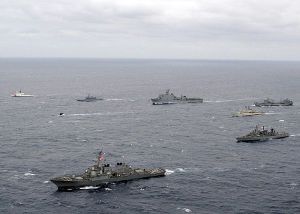
Western hemisphere navies participate in UNITAS exercise in 2007. Image: U.S. Navy
The Center for Strategic and International Studies published a multi-authored monograph last month titled “The Fourth Fleet: A Tool of U.S. Engagement in the Americas.”
This monograph discusses the U.S. Navy’s re-establishment of the 4th Fleet which is “responsible for U.S. Navy ships, aircraft, and submarines operating in the SOUTHCOM area of focus. Its aim is to strengthen cooperation and partnerships using five primary missions: support for peacekeeping, humanitarian assistance, disaster relief, traditional maritime exercises, and counterdrug support operations.”
Expanding on the importance of Latin America to U.S. national security, the monograph also address the historical context of the fleet “which waged war against raiders, blockade runners, and submarines in the south Atlantic, in addition to protecting the Panama Canal and defending against Nazi and Japanese actions during World War 2” and evolution of SOUTHCOM’s involvement in the region.
The authors suggest several opportunities for furthering U.S. policy objectives in the region: 1) The Fourth Fleet can contribute to the pursuit of a smart power strategy for the United States; 2) To reduce the skepticism and negative responses of the United States’ Latin American partners in this hemisphere, SOUTHCOM should coordinate with the Department of State to create a public diplomacy campaign to dispel any further unease about the role and mission of the Fourth Fleet; 3) Natural disasters in the region are on the rise as a consequence of climate change. The Fourth Fleet can serve as a training tool and vehicle for joint exercises with regional actors to share lessons learned and develop common practices and interoperability to enhance military support to future humanitarian relief operations in the Western Hemisphere; and 4) The new regional security climate in the Western Hemisphere includes many new actors taking on new roles in arms transfers and the pursuit of natural resources.
Perspectives presented in this paper clearly enunciate the importance of U.S. engagement in the hemisphere through the U.S. Navy’s smart power strategy as regional integration continues in development.

